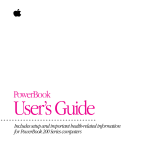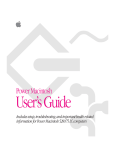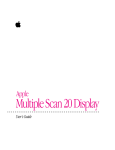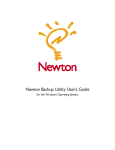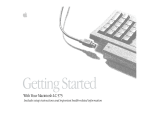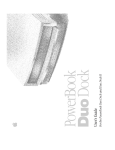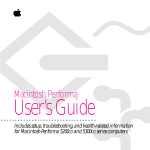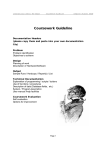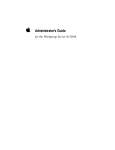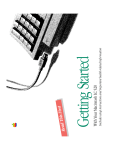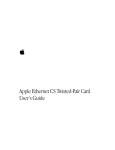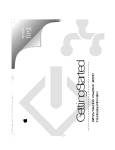Download Apple LC 550 Specifications
Transcript
Includes setup instructions and important health-related information With Your Macintosh LC 550 Getting Started st r i F s i h Read T n n Taking the Macintosh Basics tour 12 Turning the computer on and off 16 Learning the Basics 12 Plugging in the computer 2 Connecting the mouse and keyboard 3 Turning on your computer for the first time 4 Problems starting up? 6 Safety instructions 6 Health-related information about computer use 7 What’s next? 11 Setting Up 1 Communications regulation information iii Contents n n Adjusting the sound 20 Using the built-in microphone 22 Adjusting the screen 22 Disabling the buttons on the front of your computer 23 Saving energy 24 Installing an expansion card 25 Using a RAM disk for temporary storage 29 Advice about using a modem 30 Starting up your computer from an external hard disk 30 Using Special Features 20 Your Computer at a Glance 18 i ii Apple Desktop Bus and At Ease are trademarks of Apple Computer, Inc. Apple, the Apple logo, LaserWriter, and Macintosh are trademarks of Apple Computer, Inc., registered in the U.S. and other countries. © 1993 Apple Computer, Inc. 20525 Mariani Avenue Cupertino, CA 95014-6299 (408) 996-1010 Every effort has been made to ensure that the information in this manual is accurate. Apple is not responsible for printing or clerical errors. The Apple logo is a trademark of Apple Computer, Inc., registered in the U.S. and other countries. Use of the “keyboard” Apple logo (Option-Shift-K) for commercial purposes without the prior written consent of Apple may constitute trademark infringement and unfair competition in violation of federal and state laws. You may use the software on any computer owned by you, but extra copies cannot be made for this purpose. This manual and the software described in it are copyrighted, with all rights reserved. Under the copyright laws, this manual or the software may not be copied, in whole or part, without written consent of Apple, except in the normal use of the software or to make a backup copy of the software. The same proprietary and copyright notices must be affixed to any permitted copies as were affixed to the original. This exception does not allow copies to be made for others, whether or not sold, but all of the material purchased (with all backup copies) may be sold, given, or loaned to another person. Under the law, copying includes translating into another language or format. K Apple Computer, Inc. Mention of third-party products is for informational purposes only and constitutes neither an endorsement nor a recommendation. Apple assumes no responsibility with regard to the performance or use of these products. Simultaneously published in the United States and Canada. Trinitron is a registered trademark of Sony Corporation. Tektronix is a registered trademark of Tektronix, Inc. SuperPaint is a registered trademark of Aldus Corporation. QuarkXPress is a registered trademark of Quark, Inc. QMS is a registered trademark of QMS, Inc. Macintosh Basics was developed using VideoWorks Interactive. MacroMind is a registered trademark and VideoWorks Interactive is a trademark of MacroMind, Inc. Exposure is a registered trademark of Preferred Publishers, Inc. Adobe, Adobe Illustrator, Adobe Photoshop, and PostScript are trademarks of Adobe Systems Incorporated, which may be registered in certain jurisdictions. m Plug the computer into an outlet that is on a different circuit from the television or radio. (That is, make certain the computer and the television or radio are on circuits controlled by different circuit breakers or fuses.) m Move the computer farther away from the television or radio. m Move the computer to one side or the other of the television or radio. m Turn the television or radio antenna until the interference stops. If your computer system does cause interference to radio or television reception, try to correct the interference by using one or more of the following measures: You can determine whether your computer system is causing interference by turning it off. If the interference stops, it was probably caused by the computer or one of the peripheral devices. This equipment has been tested and found to comply with the limits for a Class B digital device in accordance with the specifications in Part 15 of FCC rules. These specifications are designed to provide reasonable protection against such interference in a residential installation. However, there is no guarantee that interference will not occur in a particular installation. The equipment described in this manual generates, uses, and can radiate radiofrequency energy. If it is not installed and used properly—that is, in strict accordance with Apple’s instructions—it may cause interference with radio and television reception. Radio and television interference This equipment has been tested and found to comply with the limits for a Class B digital device in accordance with the specifications in Part 15 of FCC rules. See instructions if interference to radio or television reception is suspected. FCC statement Communications regulation information Observation des normes—Classe B Cet appareil numérique respecte les limites de bruits radioélectriques applicables aux appareils numériques de Classe B prescrites dans la norme sur le matériel brouilleur : “Appareils Numériques”, NMB-003 édictée par le ministre des Communications. iii DOC Class B Compliance This digital apparatus does not exceed the Class B limits for radio noise emissions from digital apparatus as set out in the interference-causing equipment standard entitled “Digital Apparatus,” ICES-003 of the Department of Communications. DOC statement This product was tested for FCC compliance under conditions that included the use of Apple peripheral devices and Apple shielded cables and connectors between system components. It is important that you use Apple peripheral devices and shielded cables and connectors between system components to reduce the possibility of causing interference to radios, television sets, and other electronic devices. You can obtain Apple peripheral devices and the proper shielded cables and connectors through an Apple-authorized dealer. For non-Apple peripheral devices, contact the manufacturer or dealer for assistance. S S Important: Changes or modifications to this product not authorized by Apple Computer, Inc., could void the FCC Certification and negate your authority to operate the product. If necessary, consult an Apple-authorized service provider or Apple. See the service and support information that came with your Apple product. Or, consult an experienced radio/television technician for additional suggestions. You may find the following booklet helpful: Interference Handbook (stock number 004-000-00493-1). This booklet, prepared by the Federal Communications Commission, is available from the U.S. Government Printing Office, Washington, DC 20402. iv VCCI statement Plugging in the computer Connecting the mouse and keyboard Turning on your computer n n n Setting up your computer involves these steps: Optional security screws Power cord In this all-in-one computer, Apple has integrated a Trinitron® monitor for exceptional color quality, reduced the number of cables, and moved controls to the front for easy access. Set it up and learn the basics. Then explore the many options to see what you can do with Apple’s most affordable media-ready system, featuring stereo sound and an optional CD-ROM drive. Congratulations on your purchase of a Macintosh computer! Setting Up Keyboard Keyboard cable Macintosh computer Mouse 1 2 Main power switch S Important: To protect both yourself and the computer from electrical hazards, the computer should remain turned off until you are finished connecting its parts. Check the main power switch at the back of the computer. Make sure that the bottom of the switch (marked with an “j”) is pressed in. S Plug in the Macintosh before connecting anything to it. The plug grounds the computer and protects it from electrical damage while you are setting up. Plugging in the computer Power cord plug Socket end of the power cord 2. Plug the other end of the power cord into a three-hole grounded outlet or power strip. S Important: Be sure at least one end of the power cord is within easy reach so that you can unplug the computer easily when you need to. S 1. Plug the socket end of the power cord into the recessed power plug (marked with the symbol ≤) on the back of the computer. v By the way: The ◊ icon is often called the Apple Desktop Bus (ADB) icon. You may see this term in other places in the manuals that came with your computer. v The plug and the port are marked with the same icon (◊). Align the icons before you insert the plug. 1. Plug the mouse cable into the port on the right side of the keyboard. (If you prefer to use the mouse with your left hand, plug the mouse cable into the port on the left side of the keyboard.) Follow these steps to connect the mouse and keyboard: Connecting the mouse and keyboard s Warning: This equipment is intended to be electrically grounded. Your Macintosh is equipped with a three-wire grounding plug—a plug that has a third (grounding) pin. This plug will fit only a grounded AC outlet. This is a safety feature. If you are unable to insert the plug into the outlet, contact a licensed electrician to replace the outlet with a properly grounded outlet. Do not defeat the purpose of the grounding plug! s ADB port As you work with your Macintosh, you may find that you want to adjust the height of the keyboard. Your Macintosh User’s Guide provides information on adjusting the keyboard so that you can work comfortably. 3. Plug the other end of the keyboard cable into one of the ports marked with the ◊ icon on the back of the computer. If you plugged the mouse cable in on the right, for example, plug the keyboard cable in on the left. 2. Plug one end of the keyboard cable—both ends are the same—into the port on the other side of the keyboard. This icon is on both the cable and the port. 3 4 Main power switch This switch provides power to your computer, but doesn’t turn it on. 1. Press the top of the main power switch at the back of the computer. The top of the switch is marked with an “i”. To see if your hard disk already has system software installed, follow these two steps to turn on your computer. In order to start up, your computer must have special software (called system software) installed on the hard disk. Your computer may have this software already installed. Turning on your computer for the first time Power key Now your computer is on. 2. Press the Power key (marked with the P icon) on the keyboard to turn on your computer. If your screen looks like the one below, with a small, labeled picture (icon) at the top right, then system software has already been installed and your computer is ready to use. Look at “Safety Instructions,” later in this book, for important safety instructions. What you see after you turn on your computer depends on whether system software has already been installed on your hard disk. If you see a blinking question mark, you need to install system software. See Chapter 8 of the Macintosh User’s Guide for instructions on how to install system software from floppy disks. Check the label of the Install Me First disk to make sure it is for your Macintosh model. 5 v Note: The desktop is gray right now because that’s the way your computer was shipped from the factory. If you want to change the color of the desktop pattern, see Chapter 11 of the Macintosh User’s Guide. v 6 n n n n If you see a blinking question mark, you’ll need to install system software. Go to Chapter 8 of the Macintosh User’s Guide for instructions on installing system software from floppy disks. Make sure that the label of the Install Me First disk says it is for your Macintosh model. If you have an external hard disk attached to your computer, is that hard disk turned on? Was it turned on before you turned on the computer? If you’re not sure, turn everything off as described in “Turning the Computer On and Off.” Then turn on the external hard disk before you turn on your computer. Is the keyboard cable connected correctly? (Don’t disconnect the keyboard cable while your computer is on. You could damage your equipment.) you want to clean the case (use only the recommended procedure described below) you suspect that your Macintosh needs service or repair your Macintosh has been dropped or the case has been otherwise damaged your Macintosh is exposed to rain or any other excess moisture you spill something into the case the power cord or plug becomes frayed or otherwise damaged n n Never turn on your computer with any of the internal parts removed. Replace the back panel of the computer, if you ever need to remove it, before you use your computer. For additional safety: n n n n n n Turn off the computer completely and disconnect the power plug (by pulling the plug, not the cord) if any of the following conditions exists: Is the computer firmly plugged into a power source? If it is plugged into a power strip, is the power strip turned on? Is the computer itself turned on? Check to see if the power-on light on the front of your computer is green. If it’s not, you need to turn the computer on, using the main power switch at the back of the computer. For your own safety and that of your equipment, always take the following precautions. If you don’t see anything on the screen, check these items to see if you can identify the problem: n Safety instructions Problems starting up? Follow all instructions and warnings dealing with your system. Keep these instructions handy for reference by you and others. Read all the installation instructions carefully before you plug your Macintosh into a wall socket. Protect your Macintosh from dampness or wet weather, such as rain, snow, and so on. Keep your Macintosh away from sources of liquids, such as wash basins, bathtubs, shower stalls, and so on. 2. Wipe the surfaces lightly with a clean, soft cloth dampened with water. 1. Turn off the computer completely and then disconnect the power plug. (Pull the plug, not the cord.) To clean the case, do the following: s Warning: Electrical equipment may be hazardous if misused. Operation of this product, or similar products, must always be supervised by an adult. Do not allow children access to the interior of any electrical product and do not permit them to handle any cables. s n n n n n Be sure that you always do the following: 7 The most common health effects associated with using a computer are musculoskeletal discomfort and eye fatigue. We’ll discuss each area of concern below. For information about electric and magnetic emissions, look in the reference material that comes with your computer. Muscle soreness, eye fatigue, and other discomforts and injuries sometimes associated with using computers can occur from performing any number of activities. In fact, misuse of the same muscles during multiple activities can create a problem that might not otherwise exist. For example, if you engage in nonwork activities that involve repetitive stress on the wrist—such as bicycling—and also use your computer’s keyboard improperly, you may increase your likelihood of developing wrist problems. Some individuals are at greater risk of developing these problems because of their health, physiology, lifestyle, and general exposure to stress. Work organization and conditions, such as workstation setup and lighting, also play a part in your overall health and comfort. Preventing health problems is a multifaceted task that requires careful attention to the way you use your body every hour of every day. Health-related information about computer use 8 Another type of musculoskeletal concern is repetitive stress injuries (RSIs), also known as cumulative trauma disorders (CTDs). These problems can occur when a certain muscle or tendon is repeatedly overused and forced into an unnatural position. The exact causes of RSIs are not totally understood, but in addition to awkward posture, such factors as the amount of repetition, the force used in the activity, the individual’s physiology, workplace stress level, and lifestyle may affect the likelihood of experiencing an RSI. As with any activity that involves sitting for long periods of time, using a computer can make your muscles sore and stiff. To minimize these effects, set up your work environment carefully, using the guidelines that follow, and take frequent breaks to rest tired muscles. To make working with your computer more comfortable, allow enough space in your work area so that you can change position frequently and maintain a relaxed posture. Musculoskeletal discomfort No one, of course, can guarantee that you won’t have problems even when you follow the most expert advice on using computer equipment. You should always check with a qualified health specialist if muscle, joint, or eye problems occur. This section offers advice on setting up your work area to enhance your comfort while you use your computer. Since the effects of repetitive movements associated with using a computer can be compounded by those of other work and leisure activities to produce or aggravate physical problems, proper use of your computer system must be considered as just one element of a healthy lifestyle. RSIs did not suddenly arise when computers were invented; tennis elbow and writer’s cramp, for example, are two RSIs that have been with us for a long time. Although less common than other RSIs, one serious RSI discussed more often today is a wrist problem called carpal tunnel syndrome, which may be aggravated by improper use of computer keyboards. This nerve disorder results from excessive pressure on the median nerve as it passes through the wrist to the hand. n n Take frequent short breaks to give your muscles and eyes a chance to rest. Arrange your work space so that the furniture is properly adjusted for you and doesn’t contribute to an awkward working posture. To prevent discomfort and eye fatigue: Whenever you’re engaged in an activity that involves close-up work—such as reading a magazine, doing craft work, or using a computer—be sure to have sufficient glare-free lighting and give your eyes frequent rest breaks by looking up and focusing on distant objects. Remember to have your eyes examined regularly. n 9 You may have to raise your chair so your forearms and hands are at the proper angle to the keyboard. If this makes it impossible to rest your feet flat on the floor, you can use a footrest with adjustable height and tilt to make up for any gap between the floor and your feet. Or you may lower the desktop to eliminate the need for a footrest. Another option is to use a desk with a keyboard tray that’s lower than the regular work surface. When you use the computer keyboard, your shoulders should be relaxed. Your upper arm and forearm should form an approximate right angle, with your wrist and hand in roughly a straight line. The back of the chair should support your lower back (lumbar region). Follow the manufacturer’s instructions for adjusting the backrest to fit your body properly. An adjustable chair that provides firm, comfortable support is best. Adjust the height of the chair so your thighs are horizontal and your feet flat on the floor. Here are some guidelines for adjusting the furniture in your office to accommodate your physical size and shape. Eye fatigue can occur whenever the eyes are focused on a nearby object for a long time. This problem occurs because the eye muscles must work harder to view an object that’s closer than about 20 feet (6 meters). Improper lighting can hasten the development of eye fatigue. Although eye fatigue is annoying, there’s no evidence that it leads to permanent damage. n Arranging your office Eye fatigue 10 n n Thighs horizontal Lower back supported Forearms level or tilted up slightly Forearms and hands in a straight line Shoulders relaxed n n Feet flat on the floor Clearance under work surface Screen positioned to avoid reflected glare Top of the screen at or slightly below eye level (You may need to adjust the height of your computer by placing something under it or by raising your work surface.) Some computer users may develop discomfort in their hands, wrists, or arms after intensive work without breaks. If you begin to develop chronic pain or discomfort in your hands, wrists, or arms, consult a qualified health specialist. Use a light touch when typing or using a mouse and keep your hands and fingers relaxed. Change your seated position, stand up, or stretch whenever you start to feel tired. Frequent short breaks are helpful in reducing fatigue. Avoiding fatigue 45–70 cm (18–28 in.) Position the computer to minimize glare and reflections on the screen from overhead lights and windows. Arrange the computer so the top of the screen is slightly below your eye level when you’re sitting at the keyboard. The best distance from your eyes to the screen is up to you, although most people seem to prefer 18 to 28 inches (45 to 70 cm). Position your mouse at the same height as your keyboard. Allow adequate space to use the mouse comfortably. n n n n Clean your screen regularly. Keeping the screen clean helps reduce unwanted reflections. n n n n 11 Start your own work. Consult the Macintosh User’s Guide or this book if you have questions about your computer. Read the “Using Special Features” section of this book for tips on how to use some of the important features of your computer. Turn to “Your Computer at a Glance,” later in this book, for an overview of major features of your computer and instructions on how to find out more about them. Read “Turning the Computer On and Off,” later in this book, for important information. If you are new to the Macintosh, continue with the next section, “Learning the Basics,” to learn more about how to use your computer. You’ve completed setting up your computer. Continue with one of the following steps: What’s next? Eye muscles must work harder to focus on nearby objects. Occasionally focus your eyes on a distant object, and blink often while you work. Allow adequate workspace so that you can use your keyboard and mouse comfortably. Place papers or other items so you can view them easily while using your computer. A document stand may make reading papers more comfortable. The Learning Macintosh section of your Macintosh User’s Guide is a tutorial that reinforces basic skills taught in the tour, and teaches a few additional skills you’ll find helpful as you become more proficient. The Macintosh Basics tour teaches the most basic skills you need to master before you can use your computer. 12 Take the Macintosh Basics tour first. n n The Macintosh comes with a tour and a tutorial to help you start using your computer as quickly as possible. Learning the Basics Hold the mouse as shown, cable pointing away from you. Slide it so that it stays in contact with the table. Don’t press the mouse button. Watch the arrow (8) on your screen to see if it moves when you move the mouse. 1. Use your hand to scoot the mouse along the table. Make sure your computer is turned on. If the screen is dark, try adjusting the screen (as described in “Adjusting the Screen,” later in this book) until you see the Macintosh desktop on your screen. To take the tour, follow these steps: Your Macintosh Basics tour can be found on the hard disk that’s inside your computer. Taking the Macintosh Basics tour You can move the arrow by moving the mouse. If the arrow doesn’t move on the screen, make sure that the cable connecting the mouse to the keyboard is secure and that your mouse is positioned as shown in the picture. (Don’t disconnect the cable while your computer is on; you could damage your equipment.) 2. Notice that the arrow (8) moves in the direction you move the mouse. 13 continues . Put the tip of the arrow inside this picture. Make sure the tip of the arrow is over the picture, not over the words “Macintosh HD.” 3. Move the mouse so that the arrow is over the picture labeled “Macintosh HD.” Try pressing twice more quickly and be careful not to move the mouse while you press. Be sure to press the mouse button twice. Make sure the tip of the arrow is touching the picture, not the words beneath it. 14 The items in this illustration may not exactly match those on your screen. n n n Now your screen should look like the picture shown in this step. If it doesn’t, try steps 3 and 4 again, paying special attention to the following: 4. Being careful not to move the mouse, click the mouse button twice in quick succession. Make sure the tip of the arrow is over the picture, not over the words “Macintosh Basics.” Put the tip of the arrow inside this picture. 5. Move the mouse to place the tip of the arrow inside the picture of the folder labeled “Macintosh Basics.” Make sure the tip of the arrow is over the picture of the man, not over the words “Macintosh Basics.” Now your screen should look like the following illustration: 15 continues . Put the tip of the arrow inside this picture. 7. Move the mouse so that the arrow is over the picture of the man labeled “Macintosh Basics.” 6. Being careful not to move the mouse, press the mouse button twice in quick succession. 16 When you finish the tour, continue with “Turning the Computer On and Off.” Read the rest of this book for information that can help you use your computer safely and efficiently. Then turn to the Learning Macintosh section of your Macintosh User’s Guide and begin the learning exercises there. 9. Follow the instructions on the screen and work through the tour. Now your screen should look like the following picture: 8. Press the mouse button twice in quick succession. attach other equipment to the computer unplug the computer leave it for an extended period of time n n n s Warning: If you turn off the computer by pressing the main power switch on the back of the computer before shutting it down by either of the methods described next, you will lose any work you haven’t previously saved onto a disk, and you risk permanently losing open documents. s S move the computer n S Important: Use the main power switch on the back of the computer to turn the computer completely off if you need to do any of the following: When you started up your computer for the first time, you pressed the main power switch at the back of the computer. From now on, you’ll leave the main power switch on the back in the on position and shut down your computer with the keyboard or with a menu command. Both methods of shutting down are described in this section. Turning the computer on and off You will be prompted to save your work, if you haven’t already done so. 2. Click Shut Down. You see a message asking whether you want to shut down or continue working. Power key 1. Press the Power key (marked with the P icon) on the keyboard. To shut down the computer with the keyboard: Shutting down the computer with the keyboard You will be prompted to save your work, if you haven’t already done so. Use the mouse to choose the Shut Down command from the Special menu. n 17 You’ll find the Power key at the top of the keyboard. (Remember that the Power key works only if the main power switch on the back of the computer is turned on.) Press the Power key (marked with the P icon) on the keyboard. (Make sure that the main power switch on the back of the computer is in the “on” position. The top part of the switch, marked with an “i”, should be pressed in.) To turn on the computer after you have shut it down with either the menu command or the keyboard: Turning on the computer n Shutting down the computer with a menu command 18 Keyboard (See your Macintosh User’s Guide for information on adjusting the keyboard height.) (Use this key to turn your computer on and off.) P Power key Power-on light (A green light indicates that the computer is on.) Screen control buttons (Use these buttons to lighten or darken your screen.) (Use these buttons to change the volume of the computer’s sound.) _ Sound control buttons CD-ROM drive Open/Close button CD-ROM drive (optional) Your Computer at a Glance Headphone jack Stereo speakers Floppy disk drive Color Trinitron display (Supports up to thousands of colors.) Built-in microphone (See your Macintosh User’s Guide for information on recording sound.) Mouse (Connects your Macintosh to SCSI devices, such as hard disk drives, scanners, and printers. See your Macintosh User’s Guide for more information.) g SCSI port W Modem port [ Printer port V ADB ports (Connect your Macintosh to input devices, such as a keyboard or a trackball. See your Macintosh User’s Guide for more information.) I Main power switch ≤ Power plug (Connects your Macintosh to another audio source such as a compact disc or an audio cassette player.) ≈ Sound input port (Connects your Macintosh to sound output devices, such as a pair of headphones.) _ Sound output port Expansion card access cover (See the “Using Special Features” section of this book to learn how to install expansion cards.) Hole for optional security screw (You can use the screws that came with your computer to secure the back panel.) Hard disk drive (Internal) 19 Using the built-in microphone Adjusting the screen Disabling the buttons on the front of your computer Saving energy Installing an expansion card Using a RAM disk for temporary storage Advice about using a modem Starting up your computer from an external hard disk n n n n n n n n 20 Adjusting the sound n The following topics are covered here: As you work with your Macintosh, you can consult your Macintosh User’s Guide for answers to questions that you may have. This section provides information on features that are not covered in the user’s guide. v Note: If you are playing an audio compact disc or an audio track on a CD-ROM disc, see the manual that came with your CD-ROM drive. v There are two ways you can adjust the volume of the sounds that your Macintosh plays: by using the buttons on the front of the computer or by using the Sound control panel. Many programs have the Macintosh make sounds when your attention is required or when you’re giving a command or attempting an action that the computer cannot recognize or perform at that time. Adjusting the sound Using Special Features Press the button on the bottom to make the sound softer. n _ Sound control buttons Press the button on the top to make the sound louder. n You can also adjust the volume of the sounds your computer plays by using the Sound control panel. To use the Sound control panel: On the front of your Macintosh are two sets of buttons. The set on the right (marked with the - icon) is for sound control. To use these buttons to increase or decrease the volume of the sounds your Macintosh plays: 21 v By the way: You can turn off sound completely by clicking the Mute box. When the Mute box is checked and your Macintosh wants to alert you, the menu bar flashes. v After you release the mouse, the sound plays at the new volume. Drag the slider to adjust the volume. 3. Drag the Speaker Volume slider up or down to set the volume level. 2. Open the Sound control panel. 1. Choose Control Panels from the Apple (K) menu. Using the Sound control panel Using the sound control buttons on the computer 22 s Warning: Do not stick any small objects into the built-in microphone. Doing so may damage your equipment. s Built-in microphone You can adjust the level of light and dark on the screen of your built-in monitor (to change the contrast) either by using the buttons on the front of the computer or by using the Screen control panel. Your Macintosh comes with a built-in microphone to record live sounds. The microphone is highly sensitive. Once you’ve turned it on (which you do with a sound-recording program), it can pick up sounds within a range of several feet. See your Macintosh User’s Guide for information on recording sound. Press the button on the bottom to darken your screen. n Screen control buttons Press the button on the top to lighten your screen. n To use the screen control buttons (marked with the ¸ icon) on the computer: Using the screen control buttons on the computer Adjusting the screen Using the built-in microphone S Important: Normally, use only the Screen Contrast control. Don’t use the Screen Brightness control unless your screen appears dark even when the Screen Contrast slider is all the way to the right. S The screen changes as you drag the slider. Drag the slider to adjust the contrast on your screen. You should only use the Brightness control if your screen begins to appear dark after extended computer use (two to three years). 3. Drag the Screen Contrast slider to the right or left to adjust the level of light. 2. Open the Screen control panel. 1. Choose Control Panels from the Apple (K) menu. You can also use the Screen control panel to adjust the level of light on your screen. Using the Screen control panel Drag the slider to adjust the contrast on your screen. 3. To turn off the contrast and volume buttons, click the Disable Buttons box until an “X” appears. 2. Double-click the Button Disabler control panel to open it. 1. Pull down the Apple (K) menu and choose Control Panels. To use the Button Disabler control panel: The Button Disabler control panel is already installed in your Control Panels folder. You can prevent other people from using the sound and screen control buttons on the front of your computer by using the Button Disabler control panel. The disabler will not affect any other buttons on your computer or any buttons on devices connected to the computer. Disabling the buttons on the front of your computer 23 24 2. Open the Screen control panel. 1. Choose Control Panels from the Apple (K) menu. To set the screen to turn off: Turning off the screen conserves energy. It also protects the screen from “burning in” images, which can occur if you leave an unchanging image on the screen for many hours or days. Your Macintosh comes with software that reduces the amount of energy consumed when you are not using your computer. The software allows you to set the screen to turn off after a period of inactivity, the length of which you specify. The image on the screen reappears when you move the mouse or press any letter or number key on the keyboard. Because the screen needs to warm up, it will take up to 15 seconds for the picture to reappear. Saving energy v By the way: If you want to use a password to control access to the Button Disabler control panel, consider using At Ease, an application program available through an Apple-authorized dealer. v The buttons remain off until you turn them on again (by clicking the Disable Buttons box to remove the “X”). S Important: When the screen is off, the computer is still on. The green light on the front of the computer indicates that the computer is still on. S For example, if you choose 15 minutes, your screen will darken after your computer has been inactive for 15 minutes. The image will appear once again, exactly as you left it, if you move the mouse or press any letter or number on the keyboard. Because the screen needs to warm up, it will take up to 15 seconds for the picture to reappear. 4. Drag the slider to choose the number of minutes until the screen turns off. Click here to activate the screen power saver. 3. Click the box labeled “Turn off built-in screen when idle.” s Warning: To avoid damaging your computer and expansion card, do not attempt to install any expansion card without first checking the documentation for that card. If the documentation specifies that an Apple-certified technician must install the card (usually because the installation requires special training or tools), consult the service and support information that came with your computer for instructions on how to contact an Apple-authorized service provider or Apple for assistance. If you attempt to install the card yourself, any damage you may cause to the computer or card will not be covered by the limited warranty on your computer. If the card is not an Apple-labeled product, check with an Appleauthorized dealer or service provider to see if you can install it yourself. s s Warning: If you have installed a floating-point unit (FPU) on the main logic board of your Macintosh, do not install an expansion card that also contains one. If you have two FPUs, your Macintosh may not work properly. s The Macintosh comes with a slot inside called a processor-direct slot in which you can install a processor-direct expansion card for special purposes. Some expansion cards are designed so that you can install them yourself. Others can be installed only by an Appleauthorized representative. To install a card, use the documentation supplied with the card you plan to install, or follow the instructions in this section. Installing an expansion card 25 continues . 4. If there are screws on either side of the back panel, remove them. 3. Unplug the cable that connects your keyboard to the computer. 2. Turn off the computer completely by pressing the main power switch at the back of the computer. 1. Choose Shut Down from the Special menu or press the Power key on the keyboard. To install an expansion card: 26 6. Press down on the tabs and pull gently until the back panel opens. 5. Place your thumbs on the two plastic tabs on the back panel of the computer. s Warning: Don’t pull the board all the way out; this can damage your Macintosh. s 8. Slide the logic board (the board that holds the components that make your computer work) part way out until you have access to the entire slot at the right side of the board. 7. Take the back panel off and set it aside. Hold the card by its top edge to avoid touching the connector on the bottom of the card. 9. Remove the processor-direct expansion card from its static-proof bag. You’ll need to hook your fingers around the little metal boxes to pull the logic board. 27 continues . Don’t force the card. If you meet resistance, pull the card out and try again. To see if the card is properly connected, lift it gently. If it resists and stays in place, it’s connected. 11. Press down on the card until the connector is solidly in place. 10. Align the card over the expansion slot. 28 Pinch together the plastic tabs on the access cover to remove it and pop it out. With the access cover off, you can use the port on the card you just installed. 13. If there is a connector on the card that you just installed (for example, if you are installing an Apple IIe Card), remove the access cover on the back panel you removed earlier. Push on the edge of the logic board until it is finally in place. 12. Slide the logic board back in. s Warning: Never turn on your computer unless all of its internal and external parts are in place. Operating the computer when it is open or missing parts can be dangerous, and can damage your computer. s Slip the back cover over the prongs at the bottom edge of the back of the computer. If your back panel was held on by screws, replace them. 14. Replace the back panel of the computer. Leave the switch on so you can use the Power key on the keyboard to turn your computer on and to shut it down without having to turn it completely off. 16. Press the main power switch on the back of the computer. 15. Plug in your keyboard cable. s Warning: If you use a RAM disk, be sure to save your work onto another disk before turning off your computer so that you won’t lose your data. s 4. Drag the slider to indicate how much memory you want to use for a RAM disk. 29 Remember that the more RAM you allot as a RAM disk, the less you will have available for running application programs. 3. Click On to turn on the RAM disk. 2. Open the Memory control panel. 1. Choose Control Panels from the Apple (K) menu. To set up a RAM disk: You use a RAM disk exactly as you would use a hard disk or floppy disk, except that you save your work onto another disk before you shut down the computer. For improved performance, you may want to set aside part of your random-access memory (RAM) to use as a temporary hard disk. Using a RAM disk improves performance because the computer can get data from a RAM disk much faster than from a hard disk or floppy disk. Using a RAM disk for temporary storage Turn on 32-bit addressing. See your Macintosh User’s Guide for instructions. 30 n If you have virtual memory turned on, turn it off. See your Macintosh User’s Guide for instructions. S Important: Not all application programs support 32-bit addressing. The use of such programs when 32-bit addressing is turned on may cause problems with your computer. Check with the software manufacturer to find out whether your program is compatible with 32-bit addressing. S n If you use a modem with a baud rate of over 9600, you may experience some limitations in your computer’s performance. To improve performance, try the following: Advice about using a modem If you are unable to start up your Macintosh from an external disk, the appropriate System Enabler file may be missing from that disk. Use the Installer program on the Install Me First disk that came with your computer to install system software on the external disk. To start up your Macintosh from an external hard disk, the hard disk must contain a System Folder, and the System Folder must contain a System Enabler for your Macintosh. (A System Enabler file contains software necessary to start up a specific Macintosh model.) Starting up your computer from an external hard disk PostScript, the LaserWriter page-description language, was developed by Adobe Systems Incorporated. Text type is Apple’s corporate font, a condensed version of Garamond. Ornaments are custom symbols designed for Apple Computer. This Apple manual was written and edited on a desktop publishing system using Apple Macintosh computers and QuarkXPress. Proof pages were created on Apple LaserWriter printers and on QMS and Tektronix color printers. Final pages were output directly to separated film on a PostScript™-driven imagesetter. Line art was created with Adobe Illustrator. Cover art was produced with Adobe Photoshop. Screen shots were created and modified with system software, Exposure Pro, Aldus SuperPaint, and Adobe Photoshop. The Apple Publishing System 20525 Mariani Avenue Cupertino, California 95014-6299 (408) 996-1010 TLX 171-576 Apple Computer, Inc. 030-5456-A Printed in Singapore ference e r e r u t u rf book fo s i h t p e Ke





































